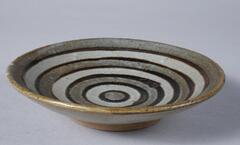54 UMMA Objects
54 UMMA Objects
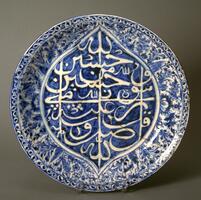
Ali ibn al-Hajj Muhammad
Platter with an inscription from a Hadith [a saying of the Prophet Muhammad], signed by Ali ibn al-Hajj Muhammad
1600 – 1799
Transfer from the College of Architecture and Design
1972/2.158
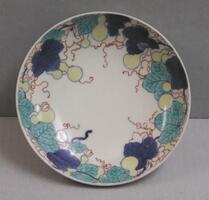
Artist Unknown, Nabeshima ware, Japan
Plate with gourd and vine design (one of five with 1964/1.100 and 102-104)
1700 – 1732
Museum purchase made possible by the Margaret Watson Parker Art Collection Fund
1964/1.101
![This dish features a three part structural division; the boss is almost flat. Around the depressed area is a band of degenerate Gothic [or pseudo-Arabic] script. On the brim are solid lustre painted zig-zags, possibly a late version of gadroons. The empty areas of this pattern are filled with dots and floral motifs. The reverse has repeated circles only. This dish features a three part structural division; the boss is almost flat. Around the depressed area is a band of degenerate Gothic [or pseudo-Arabic] script. On the brim are solid lustre painted zig-zags, possibly a late version of gadroons. The empty areas of this pattern are filled with dots and floral motifs. The reverse has repeated circles only.](/media/W1siZiIsIjIwMjIvMDUvMjUvNHVtdXlvNGgwcF9kZWZhdWx0LmpwZyJdLFsicCIsInRodW1iIiwiMjQweDIwMCJdXQ?sha=4c312278c29b047b)
Moorish (Moorish)
Shallow Dish
16th century
Transfer from the College of Architecture and Design
1972/2.119
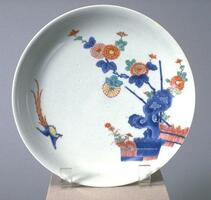
Japanese (Japanese (culture or style))
Arita ware dish with design of chrysanthemums by a brushwood fence
1700 – 1732
Gift of Mr. and Mrs. George F. Green
1970/2.1

Nicola da Urbino
Dish (Tondino) with portrait of a young woman and grotesque decoration
1526
Museum Purchase
1965/2.79
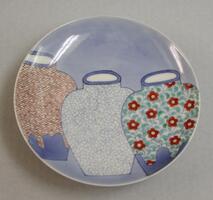
Artist Unknown, Nabeshima ware, Japan
Plate with three vase design (one of five with 1964/1.100-103)
1700 – 1732
Museum purchase made possible by the Margaret Watson Parker Art Collection Fund
1964/1.104

Moorish (Moorish)
Dish with Floral Motifs
17th century
Transfer from the College of Architecture and Design
1972/2.120
![A glazed and speckled porcelain offering dish for an altar. The base is a wide decorated cylinder which tapers sharply into a narrow top. The base supports a wide, shallow bowl.<br />
<br />
This ritual dish was produced at a regional kiln. It is a low-quality object with a rough texture, made from the clay mixed with sand, contaminated with many impurities on the tray. Its glaze is dark with blue-green tints, giving the vessel the appearance of celadon. Its foot has an octagonal cross-section.<br />
[Korean Collection, University of Michigan Museum of Art (2014) p.200] A glazed and speckled porcelain offering dish for an altar. The base is a wide decorated cylinder which tapers sharply into a narrow top. The base supports a wide, shallow bowl.<br />
<br />
This ritual dish was produced at a regional kiln. It is a low-quality object with a rough texture, made from the clay mixed with sand, contaminated with many impurities on the tray. Its glaze is dark with blue-green tints, giving the vessel the appearance of celadon. Its foot has an octagonal cross-section.<br />
[Korean Collection, University of Michigan Museum of Art (2014) p.200]](/media/W1siZiIsIjIwMjIvMDkvMjQvNm45anZucHNldV9kZWZhdWx0LmpwZyJdLFsicCIsInRodW1iIiwiMjQweDIwMCJdXQ?sha=ccdbeadfd710d294)
Korean (Korean (culture or style))
Altar Dish
1850 – 1899
Gift of Ok Ja Chang and the Chang Family
2009/2.47

Japanese (Japanese (culture or style))
Arita ware shallow dish with landscape scene of fishing boats by a willow tree
19th century
Gift of Toshiko Ogita in memory of Tomoo Ogita
1987/1.304
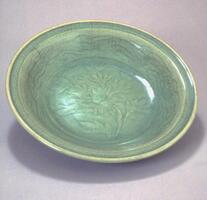
Chinese (Chinese (culture or style))
Dish
15th century
Gift of Stephen H. and Patricia O. Spurr from the Henry Jewett Greene Collection
2000/1.24
Loading…
![This is a ritual dish assumed to have been produced at the private kiln near Bunwon-ri to supply the general pulic. The dish is deeper than the most other ritual vessels produced at the official court kilns, while the diameter of the mouth is small in relation to the maximum diameter of the foot. The clay and glaze are well fused. However, the the glazed surface has darkened due to the contamination by large amounts of ash. The base of the foot shows many traces of coarse sand supports. This type of ritual vessel with high foot is unique and simple in form that it was one of the Joseon ceramic vessels that was widely sought after by Western collectors.<br />
[Korean Collection, University of Michigan Museum of Art (2014) p.197] This is a ritual dish assumed to have been produced at the private kiln near Bunwon-ri to supply the general pulic. The dish is deeper than the most other ritual vessels produced at the official court kilns, while the diameter of the mouth is small in relation to the maximum diameter of the foot. The clay and glaze are well fused. However, the the glazed surface has darkened due to the contamination by large amounts of ash. The base of the foot shows many traces of coarse sand supports. This type of ritual vessel with high foot is unique and simple in form that it was one of the Joseon ceramic vessels that was widely sought after by Western collectors.<br />
[Korean Collection, University of Michigan Museum of Art (2014) p.197]](/media/W1siZiIsIjIwMjIvMDkvMjQvMnJ2dzIwdHZ0a19kZWZhdWx0LmpwZyJdLFsicCIsInRodW1iIiwiMjQweDIwMCJdXQ?sha=38d51954f86a9ca4)
